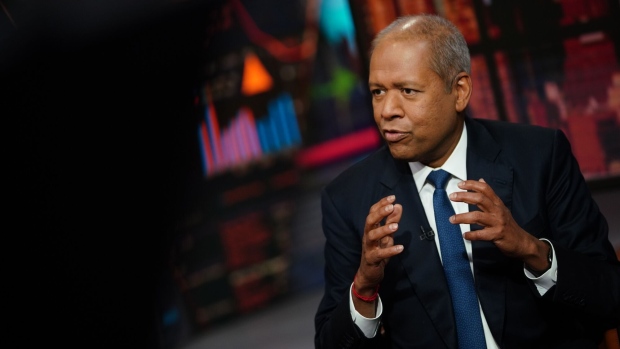Feb 12, 2024
New Barclays Team to Get Guidance on How to Avoid Greenwashing
, Bloomberg News

(Bloomberg) -- After assembling more than 100 bankers in a new transition finance team, Barclays Plc is now setting parameters for how to expand the business without being accused of greenwashing.
The new team within the corporate and investment banking unit, which will arrange financial products and deals intended to help clients reduce their carbon footprint, is among the first at a major bank to be handed a definition of so-called transition finance.
Already a buzzword in climate finance, transition is supposed to convey the notion of transforming an asset from brown to green. But as the finance industry constructs a multitrillion-dollar business around the concept, regulators have yet to explicitly define it. The concern is that when a regulatory definition finally arrives, the finance industry will be on the wrong side of it.
“There’s a real need to define transition finance,” Daniel Hanna, Barclays’ global head of sustainable finance for its corporate and investment bank, said in an interview.
Across the finance industry, the term “transition” is currently being applied to everything from solar panels to coal plants, so long as a case can be made that the capital provided helps make the world greener. In the case of coal, for example, capital could be allocated if it’s used to help owners move away from the planet’s dirtiest fossil fuel and over to something less carbon intensive, like gas. Coal is also sometimes listed as a transition asset if owners have committed to the early retirement of plants.
“An important chunk” of transition finance entails putting carbon-intensive sectors such as oil, gas, aviation and agriculture on the road to net zero greenhouse-gas emissions, Hanna said. “The challenge is to do that in a way that is robust and can withstand scrutiny,” and without raising “concerns that by putting capital to work in some of these hard-to-abate sectors you’re effectively greenwashing.”
Barclays is also stepping up pressure on energy clients to adjust their business so they can be treated as transition assets. Last week, the bank announced it will halt the direct financing of new oil and gas projects, and said energy clients will be met with “clear expectations of transition strategies and decarbonization requirements.”
Barclays’ Definition of Transition Finance:
“As there is no universal consensus as to how to define ‘transition’ activities, for purposes of financings included in our target, Barclays has developed its own definition of transition finance as follows:
“Transition finance is any financing including lending, capital markets and other financing solutions provided to clients for activities (including technologies) that support greenhouse gas emission reduction, directly or indirectly, in high-emitting and hard-to-abate sectors towards a 1.5C pathway.”
Climate activists remain skeptical. Lucie Pinson, director of French climate nonprofit Reclaim Finance, said it is “good to see” that Barclays is now requiring clients to adopt transition plans. However, the bank has “failed to address the most urgent issue of halting oil and gas expansion,” she said. And Barclays hasn’t committed to stop financing existing oil and gas clients after 2025, “even though these companies can’t claim to be in transition if they are developing new fossil fuel projects,” according to Pinson.
Laura Barlow, Barclays’ head of sustainability, characterized the financing switch needed to address climate change as “complex.” She also emphasized that the bank will work with energy clients to reduce their carbon footprint in “a manner that is just, orderly and addresses energy security.”
Read More: HSBC Tells Clients It Won’t Blacklist Major Polluters
Hanna says Barclays based its transition framework on scenarios outlined by the International Energy Agency and the United Nations’ Intergovernmental Panel on Climate Change. So the bank’s terms are “very much informed by the decarbonization levers referred to in some of the 1.5C no-overshoot scenarios,” he said.
Barclays is also paying attention to what governments are signaling in terms of where “they want capital to move,” both with regard to the European Union’s green taxonomy and the US Inflation Reduction Act, Hanna said.
Read More: Energy Transition Spend Hits Record Lead Over Fossil Fuels: BNEF
Barclays’ lending to oil and gas made up about 2% of its total loan book and 2.6% of its capital markets’ business, according to its 2022 annual report. It provided $4.9 billion in loans to the fossil-fuel industry in 2023, compared with an annual average of $7.2 billion over the preceding seven years, data compiled by Bloomberg show.
In the UK, where Barclays is based, the Transition Plan Taskforce recently unveiled a framework for corporations to use. Michelle Scrimgeour, chief executive of Legal & General Investment Management, said back in October that the TPT will help piece together the data investors need to assess whether companies are making “credible progress” around their transition claims. And on a global level, the Financial Stability Board has said it’s analyzing the relevance of transition plans for financial stability.
Read More: UK Closer to Mandatory CO2 Disclosures With New Guidelines
Hanna said the lack of a definition and a widely agreed upon taxonomy is “one of the big impediments to putting more capital to work” for the energy transition.
“I’ve had conversations with investors who have expressed an interest in putting more capital to work on the transition,” he said. But they’re “quite concerned about being accused of greenwashing given the lack of agreed standards.”
Barclays has pledged $1 trillion of sustainable and transition finance by 2030. Hanna said the intention is for the public now to “look at our definition and comment, criticize and improve it.”
(Adds reference to HSBC and coal financing in 10th paragraph.)
©2024 Bloomberg L.P.


